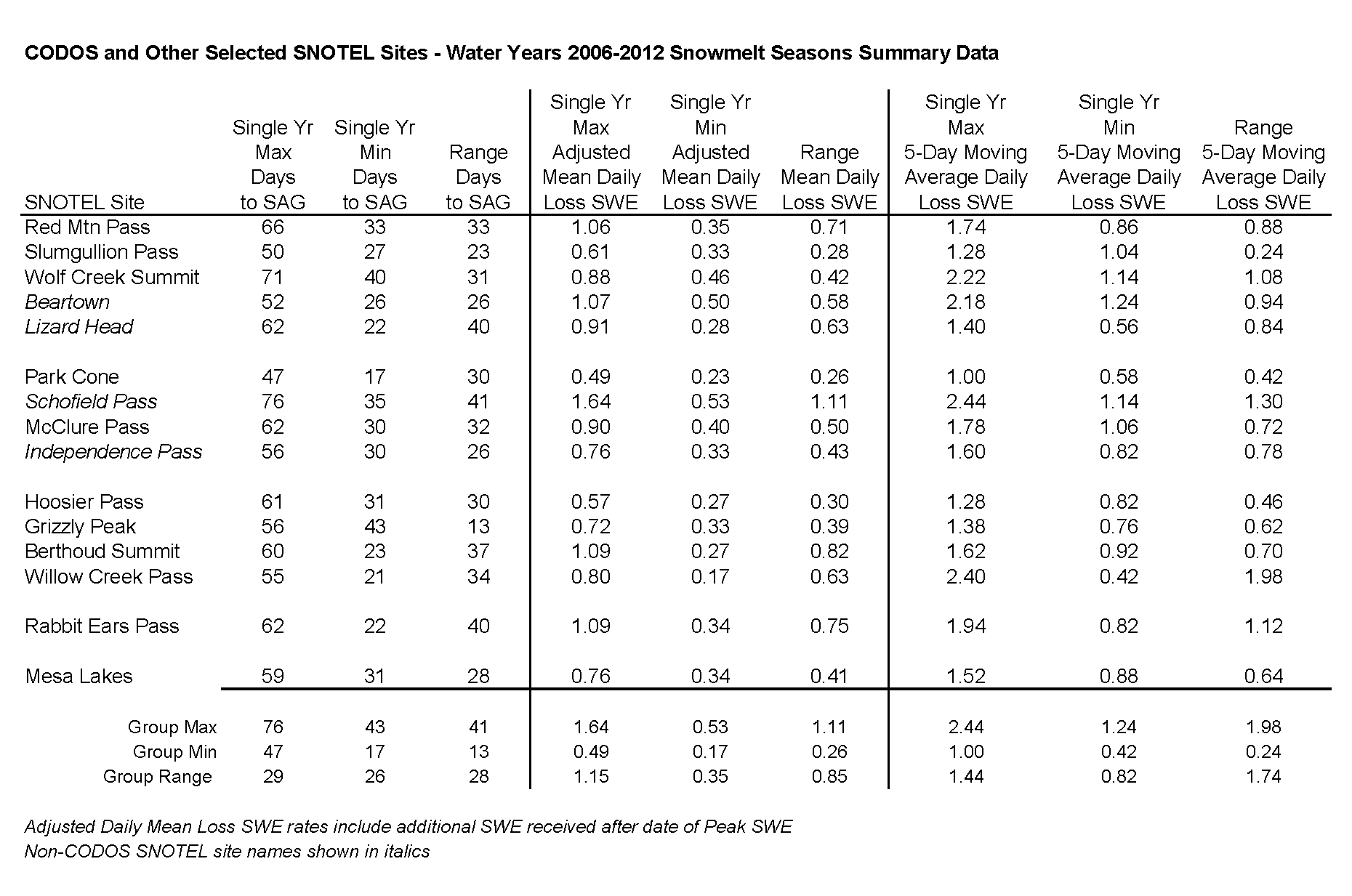CODOS Update for Northern, Front Range, and Grand Mesa CODOS sites
Late April and early May snowfalls have served to both increase snowpacks in the northern and Front Range mountains while also largely delaying the effects of WY 2013 dust events D6 (April 8) and D8 (April 15-17) on snowmelt. A recently completed circuit of six CODOS sites found a variety of conditions in the upper snowpack, with D8 well covered by clean snow in the Front Range but already exposed at the snowpack surface farther north. (This circuit, and a recent circuit of our southwestern sites, verified that event D8 produced very heavy dust deposition statewide). In the Front Range, the inevitable emergence of D8 will require ablation of clean snow containing approximately 2-4” of SWE, assuming no additional new snow. As of this writing, snowmelt rates at some of the Snotel sites associated with our CODOS sites are already accelerating. All CODOS snow profiles performed on this circuit found isothermal snowcover at 0° C throughout (with the exception of subfreezing temperatures at the very surface, in early morning).
CODOS Site & Adjacent Snotel |
SWE at Snotel as of 0001 hours |
Measured SWE above D8 dust at CODOS Site |
||
Date |
SWE |
Date |
SWE |
|
Hoosier Pass |
May 9, 2013 |
16.4” |
May 9, 2013 |
3.1” |
Grizzly Peak |
May 10, 2013 |
17.6” |
May 10, 2013 |
2.4” |
Berthoud Summit |
May 10, 2013 |
22.9” |
May 10, 2013 |
3.4” |
Willow Creek Pass |
May 10, 2013 |
18.7” |
May 10, 2013 |
0.0” |
Rabbit Ears Pass |
May 11, 2013 |
19.3” |
May 11, 2013 |
0.0” |
Grand Mesa (Mesa Lakes) |
May 11, 2013 |
12.9” |
May 11, 2013 |
1.1” |
Table 1: SWE conditions at Snotel sites adjoining Front Range and northern CODOS monitoring sites, and measured SWE now overlying dust-on-snow layer D8 (April 15-17) at those CODOS sites. Snotel data are as of 0001 hours (just after midnight) the day of the CODOS site visit. |
||||
The photos below illustrate conditions at those six CODOS sites, and in their locales, during the recent site visits.
Table 2, below, presents summary data regarding snowmelt rates at those and additional Snotel sites for Water Years 2006-2012. Days to “snow all gone” (SAG), mean daily rates of SWE loss, and 5-day moving average SWE loss rates are analyzed. Table 2 is intended to provide a reminder of melt rates observed during prior seasons, and describe a range of rates that could erode the snowcover now overlying layer D8 (as shown in Table 1). It is worth noting that some of the recent late April and early May snows fell on previously bare ground. This most recent CODOS circuit found fresh snow to previously dry valley floors, and South Park completely snow covered (by 5-6” of fresh snow). However, just as radiation penetrates several inches of fresh snow to be absorbed by an underlying dust-in-snow layer near the top of a snowpack, radiation will also penetrate and ‘see’ the ground surface underneath, where snow fell on bare ground. As a result, melt rates may not differ much between fresh snow covering dust on an isothermal snowpack and the same amount of fresh snow over bare ground.
Exposure of dust layer D8 in these Front Range and northern mountain sites, and at Grand Mesa, will result in sudden accelerations of snowmelt, at all elevations, and a rapid return to and surging past the streamflow levels observed in late April. If mid-May weather remains largely sunny for a period of days, discharge levels could significantly exceed daily median values at a given gauge, under the intense radiative forcing of snowmelt produced by the heavy D8 dust layer.
As of this writing (Sunday afternoon, May 12, 2013), the National Weather Service anticipates partly sunny skies early this week at Front Range passes, with chances of afternoon showers, trending toward increasingly sunny and drier days later in the week as southwesterly flow returns. Temperatures will be in the upper 40’s and low 50’s at pass elevations. Farther north, the same general trend toward increasingly sunny and unseasonably warm weather is expected. Farther west, the Grand Mesa will see mostly sunny skies all week, with temperatures reaching 60°. Here in the southwest mountains, we may see a few diurnal showers but skies will be at least partly sunny all week and temperatures will climb to the low 60’s. In short, the expected weather conditions favor the snowmelt and runoff scenarios, enhanced by D8, described above.

